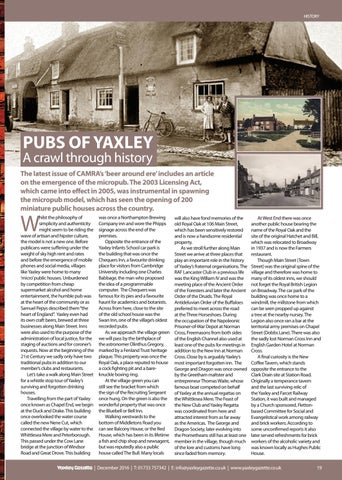HISTORY
PUBS OF YAXLEY
A crawl through history
The latest issue of CAMRA’s ‘beer around ere’ includes an article on the emergence of the micropub. The 2003 Licensing Act, which came into effect in 2005, was instrumental in spawning the micropub model, which has seen the opening of 200 miniature public houses across the country.
W
hilst the philosophy of simplicity and authenticity might seem to be riding the wave of artisan and hipster culture, the model is not a new one. Before publicans were suffering under the weight of sky high rent and rates and before the emergence of mobile phones and social media, villages like Yaxley were home to many ‘micro’ public houses. Unburdened by competition from cheap supermarket alcohol and home entertainment, the humble pub was at the heart of the community or as Samuel Pepys described them “the heart of England”. Yaxley even had its own craft beers, brewed at three businesses along Main Street. Inns were also used to the purpose of the administration of local justice, for the staging of auctions and for coroner’s inquests. Now at the beginning of the 21st Century we sadly only have two traditional pubs in addition to our member’s clubs and restaurants. Let’s take a walk along Main Street for a whistle stop tour of Yaxley’s surviving and forgotten drinking houses. Travelling from the part of Yaxley once known as Chapel End, we begin at the Duck and Drake. This building once overlooked the water course called the new Nene Cut, which connected the village by water to the Whittlesea Mere and Peterborough. This passed under the Cow Lane bridge at the junction of Windsor Road and Great Drove. This building
was once a Northampton Brewing Company inn and wore the Phipps signage across the end of the premises. Opposite the entrance of the Yaxley Infants School car park is the building that was once the Chequers Inn, a favourite drinking place for visitors from Cambridge University including one Charles Babbage, the man who proposed the idea of a programmable computer. The Chequers was famous for its pies and a favourite haunt for academics and botanists. Across from here, close to the site of the old school house was the Swan Inn, one of the village’s oldest recorded pubs. As we approach the village green we will pass by the birthplace of the astronomer Olinthus Gregory, marked by a Fenland Trust heritage plaque. This property was once the Royal Oak, a place reputed to house a cock fighting pit and a bareknuckle boxing ring. At the village green you can still see the bracket from which the sign of the Recruiting Sergeant once hung. On the green is also the wonderful property that was once the Bluebell or Bell Inn. Walking westwards to the bottom of Middletons Road you can see Balcony House, or the Red House, which has been in its lifetime a fish and chip shop and newsagent, but was reputedly also a public house called The Bull. Many locals
will also have fond memories of the old Royal Oak at 106 Main Street, which has been sensitively restored and is now a handsome residential property. As we stroll further along Main Street we arrive at three places that play an important role in the history of Yaxley’s fraternal organisations. The RAF Lancaster Club in a previous life was the King William IV and was the meeting place of the Ancient Order of the Foresters and later the Ancient Order of the Druids. The Royal Antideluvian Order of the Buffaloes preferred to meet across the road at the Three Horseshoes. During the occupation of the Napoleonic Prisoner-of-War Depot at Norman Cross, Freemasons from both sides of the English Channel also used at least one of the pubs for meetings in addition to the New Inn at Norman Cross. Close by is arguably Yaxley’s most important forgotten inn. The George and Dragon was once owned by the Greetham maltster and entrepreneur Thomas Waite, whose famous boat competed on behalf of Yaxley at the annual regattas on the Whittlesea Mere. The Feast of the New Club and Yaxley Regatta was coordinated from here and attracted interest from as far away as the Americas. The George and Dragon Society, later evolving into the Prometheans still has at least one member in the village, though much of the lore and customs have long since faded from memory.
At West End there was once another public house bearing the name of the Royal Oak and the site of the original Hatchet and Bill, which was relocated to Broadway in 1937 and is now the Farmers restaurant. Though Main Street (Town Street) was the original spine of the village and therefore was home to many of its oldest inns, we should not forget the Royal British Legion on Broadway. The car park of the building was once home to a windmill, the millstone from which can be seen propped up against a tree at the nearby nursey. The Legion also once ran a bar at the territorial army premises on Chapel Street (Dobbs Lane). There was also the sadly lost Norman Cross Inn and English Garden Hotel at Norman Cross. A final curiosity is the New Coffee Tavern, which stands opposite the entrance to the Clark Drain site at Station Road. Originally a temperance tavern and the last surviving relic of the Yaxley and Farcet Railway Station, it was built and managed by a Church sponsored, Flettonbased Committee for Social and Evangelistical work among railway and brick workers. According to some unconfirmed reports it also later served refreshments for brick workers of the alcoholic variety and was known locally as Hughes Public House.
Yaxley Yaxley Gazette Gazette || December December 2016 2016 || T: T: 01733 01733 757342 757342 || E: E: info@yaxleygazette.co.uk info@yaxleygazette.co.uk || www.yaxleygazette.co.uk www.yaxleygazette.co.uk
19 19
